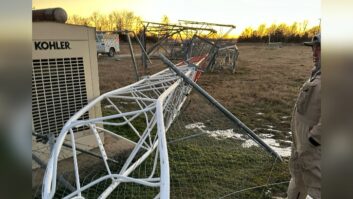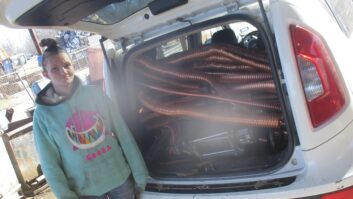(click thumbnail)The silver formula of Conducto-Lube reduces contact resistance.Tom Norman, CPBE, was once the chief engineer of KVZK(TV) in American Samoa.
In those days, there was still an operational, though crippled, aerial tramway connecting Mauga O Ali’i on one side of the harbor with the transmitter site at Mt. Alava. The tram was powered by a 100 HP three-phase motor and a control system consisting of things like contactors, saturable core reactors, electrical tachometers and other stuff that would now be considered exotic.
Power was delivered to this entire system by way of a circuit disconnect box containing three 275 Amp fuses. One day, the tram supervisor called to ask if Tom had any ideas why the fuses kept blowing. His solution is something that should be in every engineer’s bag of tricks.
The Cool-Amp Conducto-Lube Company manufactures two products. One is silver plating powder, the other is a conductive silver grease. Take a look at www.cool-amp.com for information.
While working in the Electrical Engineering Labs at the University of Wyoming, Tom used the Cool-Amp powder to plate printed circuit boards. During his career, he has used the conductive silver grease to revive failed slide switches and such.
But for the aerial tramway in American Samoa, Tom coated the ends of the fuses with Conducto-Lube, and the problem with fuses blowing due to contact resistance disappeared immediately.
This was all the more remarkable due to the highly corrosive environment of the tropics and the 30 years the disconnect box had been living in that environment.
This stuff is expensive, but Tom can’t think of anything that is even parallel to it. A small quantity of this conductive lubricant will solve all kinds of problems.
Tom Norman is a senior engineer with Burst Video.
* * *
If you don’t peruse Radio World Online, you’re missing some great stories.
Here’s a case in point. As reported on RWO, broadcasters and authorities in Eugene, Ore., recently met to talk about the growing problem of metal theft there.
(click thumbnail)Document all ground points with a digital photo.Cumulus engineer Tom Woods reports that non-ferrous metal theft in Eugene has gotten worse over the last year, with several stations losing metal from transmitter sites. Thieves broke through their tower fence and made off with a piece of 3-1/8-inch oxidized outer conductor. Others have not more unfortunate. KPNW, for instance, had its entire AM above-ground counterpoise ground system cut up and taken away.
Meetings involving the local SBE chapter and the Lane County Sheriff’s office have proven effective in helping to deal with the copper theft.
Raising awareness is a start, but the engineers also took a specific step that should catch future thieves.
The group prepared a plywood panel of samples of different types of feed-line and ground radial wire. The panel now hangs on a wall at Schnitzer Steel, the major recycler in the area. The recyclers will use the board of samples to match up similar types of recyclables. If there is a match, Schnitzer’s will start calling numbers from a list of broadcast engineers who can help determine it the recycled metal had been stolen.
In addition, the recycling company has agreed to start asking for business cards from recyclers, to determine if they are, in fact, legitimate owners of any recyclable metal that resembles anything that broadcasters use.
Perhaps your SBE chapter would like to take on a similar project for your local recycling companies.
In the meantime, broadcasters in Eugene were asked by the sheriff’s office to improve lighting and check locks at sites, to discourage future theft. Some great ideas, Tom! Thanks for sharing them with us.
* * *
Speaking of grounding, now is a good time to document perimeter grounding with your digital camera. These pictures, like the one shown in Fig. 2, can be useful should an insurance claim be necessary. It also gives you the opportunity to check that all grounds are secure — and that wire, rod or strap haven’t been stolen.
AM engineers, if your directional parameters go out, check your ground system before cranking on the phasor. Walk all the towers and check that the ground system is intact. Again, taking pictures might save you if theft occurs.
* * *
Bob Culver, principal in the firm Lohnes and Culver, writes that he finds our Workbench columns interesting and informative. It is nice to know that others have found problems similar to ones Bob has resolved and have discovered their own — sometimes unique and entertaining — solutions.
To our discussion of UPS power supplies and standby generators Bob adds this experience:
When he was involved in the DAB field testing project, designing the test plan and the vehicle to conduct the testing, he obtained a large camper-type vehicle and planned for lots of AC power for it. This included two Onan 6 kW low-speed gasoline generators and two Best Power Products uninterruptible power supplies to go with them.
Being good engineers, the testers purchased the newest items within their budget. The generators had solid-state regulation circuits. The UPS’s, Fortress models, used solid-state monitoring and regulation. The vendors of both were told how the devices would be used.
Unfortunately, the two systems fought each other. The uninterruptible power supplies worked flawlessly on “shore power” but would not accept the generator power because of some slight voltage “regulator” glitches in the generator output waveform.
The supplies were programmable, and with the help of the manufacturer and access to some “secret” programming lines, Bob and his crew attempted to tailor the input alarm and output control values to make them work. No luck.
The UPS’s were loaners for the duration of the tests, and the vendor graciously took them back and substituted Ferrups supplies, which worked just fine. It turned out that the engineering intuition was worth following — there were some occasions when a generator would go off-line, and the UPS operation saved hours of testing that the power fault would have destroyed.













